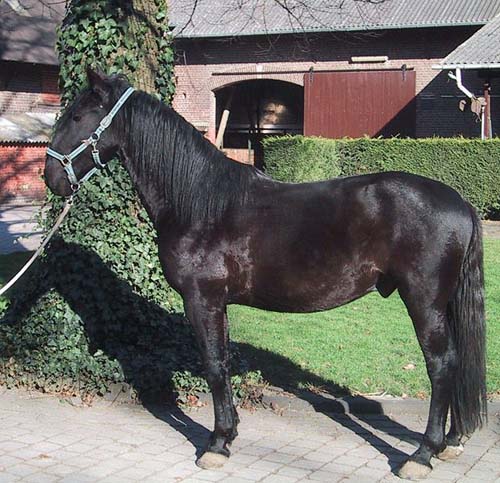|

Kladruber
Photograph by Hü. License: Public Domain.
|
|
|
FACTS
|
Description
The Kladruber (also known as Kladrub or Kladruby) is a Czech horse breed. Traditionally, Kladruber horses were selected for their size and in older times they were famous for their large frames. Nowadays, selective breeding has somewhat reduced their size, although they are still larger than most breeds. The large, rectangular frame is counterbalanced by the elegant head with its distinctive Roman profile. The Kladruber has large, gentle eyes, small ears and a strong, high set and arched neck. The chest is deep and wide, the cannons well defined and long and the hindquarters rounded and wide.
Size
16.2 - 17 hands high.
Colours
Most are grey or black. They may come in other colors (e.g. white), but these are less common.
Temperament
They are hard working, loyal and will do whatever is asked of them, always displaying great stamina and endurance. They have a calm disposition and are gentle natured.
Suitable for
Kladrubers have traditionally been bred to be carriage horses. Although they are still used as driving horses today, they are also particularly popular in competitive driving, having won many championships, as well as in dressage. Their regal appearance makes them excellent ceremonial horses too. For example, in 1994, the Danish Royal Family bought a few stallions to be used in various ceremonies. Kladrubers are also used for leisure riding while their docile nature makes them excellent mounts for therapeutic riding.
Care
They need to have a constant supply of water and food as well as frequent outdoors access in order to exercise. Kladrubers are generally healthy horses known for their longevity; however, they still require frequent veterinary check ups and vaccinations in order to remain healthy. Grooming your horse regularly will help maintain its coat in a good condition.
History
The horse has been bred in Czechoslovakia for more than 400 years, making it one of the oldest horse breeds. Its parent breeds were Italian and Spanish which were crossed with Czech and northern European breeds. For the first 200 years of its breeding, the Kladruber came in many colors; after a fire in 1759 however, all of the breed's records were destroyed, resulting in Kladrubers being bred mainly in grey and black. At some point, black Kladrubers became almost extinct. Professor Prantisek Bilek took the initiative to restore their numbers and started breeding black Kladrubers again in the 1930's having only 20 individuals to begin with. The breed has been recognized by the United Nations as a World Cultural Monument. It is the only horse breed to have ever achieved the status of a living work of art. In 1994 two stallions were sent to Spain, in order to start a Spanish Kladruber line.
Breeding
In the last decade, the breed has undergone thorough genetic analyses. In 2002 it was decided that the crossing of Kladrubers with other horse breeds should stop in order for the breeds' unique traits to be preserved. Kladrubers have an average lifespan of 25-30 years.
|
|

